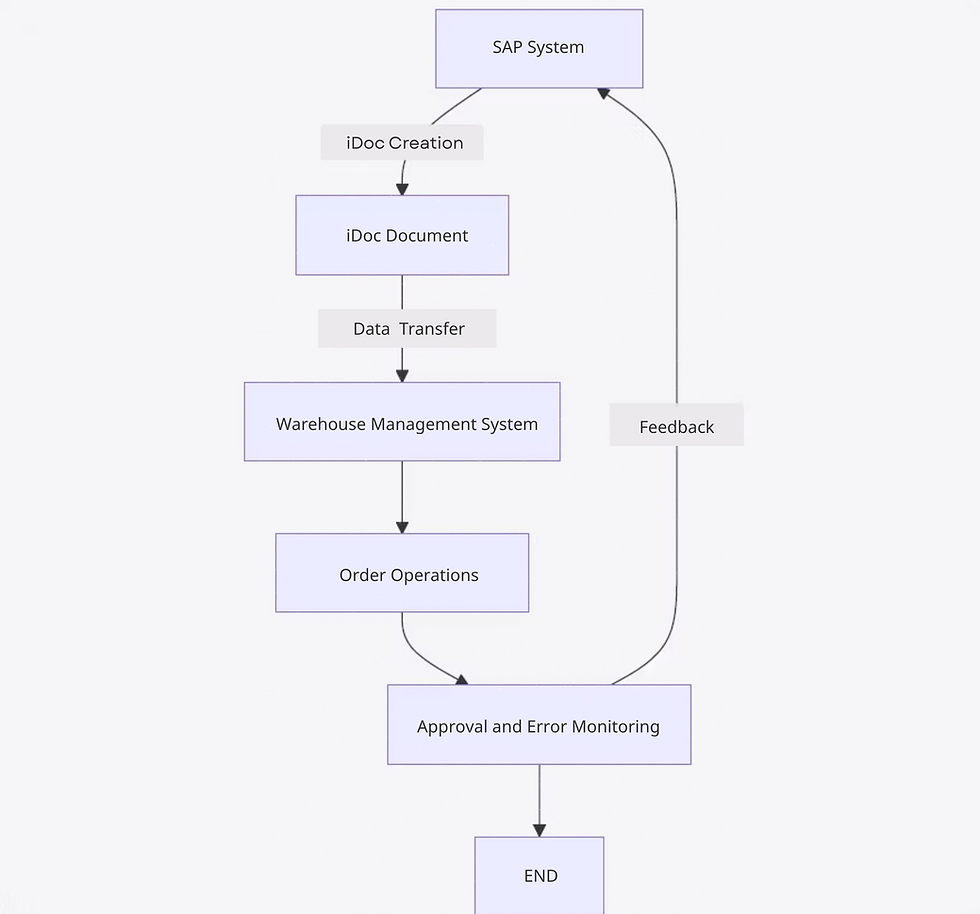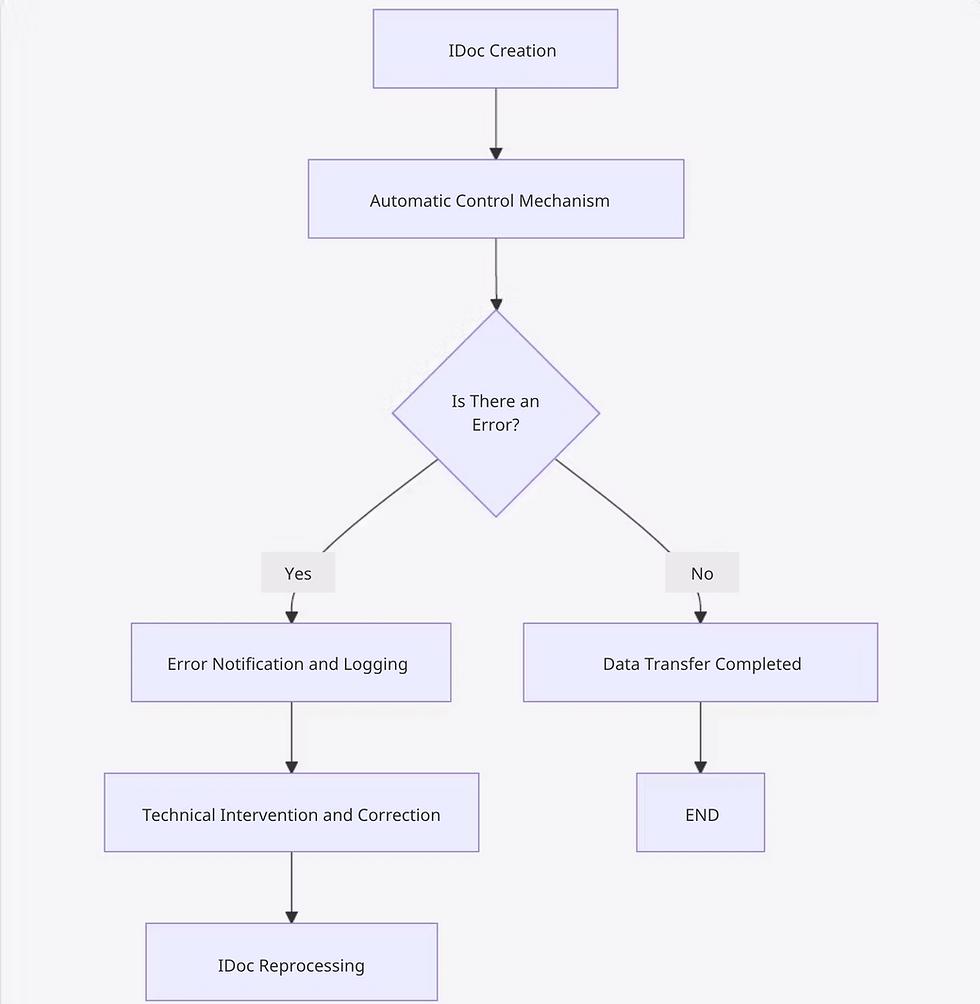SAP Projects: Fundamental Concepts and IDoc Integration Processes
- Duygu Şener

- Jul 4
- 12 min read

Integration in SAP projects plays a critical role in ensuring the continuity of corporate data exchange and the seamless execution of business processes. Technologies such as IDoc (Intermediate Document) and ALE (Application Link Enabling) standardize data transfer between different systems, providing a compatible working environment.
This article is a comprehensive review prepared for an SAP project and support manager to grasp IDoc and ALE integration processes in general terms and to evaluate these processes from a project management perspective. It is supported by examples illustrating the integration methods applied in international companies, such as Vitesco Technologies, and their role in optimizing business processes.
The study outlines the general framework of integration processes without delving into excessive technical detail and elaborates on the critical integration challenges managers encounter during project phases and the precautions that need to be taken. Additionally, the role of the SAP specialist in integration processes and how these processes reflect on business operations will be discussed through case analyses and comparative evaluations.
SAP and Fundamental Concepts
SAP, which stands for Systems, Applications, and Products in Data Processing, is a centralized ERP (Enterprise Resource Planning) software that integrates various business processes such as finance, production, human resources, and sales within an organization. SAP modules offer solutions in areas like materials management/purchasing (MM), financial accounting (FI), and sales and distribution (SD). This integrated structure accelerates the flow of data between departments, reduces redundancies and errors, and thereby increases organizational efficiency. Understanding the fundamental concepts of SAP is the first step toward effectively grasping the technical details that follow.
Overview of iDoc and ALE Concepts
Learning the language of SAP is like learning the traffic rules of a new country. At first, everything seems complicated; you constantly encounter new terms and processes. Yet, at the core of most technical concepts lie analogies familiar from business life. IDoc and ALE are no exception in this regard. Let us now simplify these two fundamental concepts from a perspective anyone can understand.
ALE (Application Link Enabling): ALE is a middleware technology that enables data exchange between SAP systems or between SAP and non-SAP systems. To use an analogy, ALE is like the courier service within a company that organizes the delivery of documents (for example, purchase forms) between different departments. It provides reliability and flexibility in data transfer. ALE establishes the infrastructure, communication rules, and messaging model for data transfer between SAP systems or with external platforms. It determines which data will be sent, to which systems, and when. In other words, it designs and manages which parcel will be delivered to which address under what conditions.
IDoc (Intermediate Document): iDoc is a data exchange format used within SAP systems, with its full name being “Intermediate Document.” It can be considered the digital representation of the electronic documents sent by ALE. It is the structured digital form of the data being sent or received according to a specific schema. In short, it is the document inside the parcel within the company, detailing who it came from, who it is going to, what the content is, and through which stages the document has passed. In other words, it is the purchase form itself being sent. The IDoc structure consists of three main parts:
Control Record: Contains information such as the sender, receiver, and document type, similar to the label on a parcel.
Data Record: Holds the detailed content of the document, such as product information, price, and quantity. This is the most comprehensive part of the IDoc, containing the actual data. Here, data elements and records are stored in a structured format, with each data element corresponding to a specific business process or application area.
Status Record: Tracks the stage of the document (created, sent, delivered, etc.).
Let’s consider a real-life example: The Human Resources department updates employee information. This updated data needs to feed into payroll systems or be transmitted to other systems. In SAP, this data transfer is carried out via ALE, which acts as the courier service, while all the details being transferred are sent in the form of an IDoc.
Where does this process appear in practice?
Sales Process: Transfer of orders to different systems or external applications
Billing and Payment: Exporting or importing account transactions and reconciliations
Logistics Management: Transfer of warehouse and shipment information
Human Resources: Updating personnel movements in the central system
Thanks to this structure, IDocs can be used as outbound (data output from a system, e.g., sending an invoice) and inbound (data input into a system, e.g., receiving a sales order), and asynchronous data transmission allows data to be reliably transferred even if the receiving system is offline. Every SAP project, whether in supply chain, human resources, or finance, requires the modular structure of IDocs. A wide range of business processes, from order to invoice, payroll to shipment, flow through IDocs.
The Use of iDoc in SAP Integration Processes
The use of the iDoc structure in SAP projects plays a fundamental role in ensuring the secure and error-free transfer of corporate data. For example, in logistics projects carried out by Vitesco Technologies, the use of IDocs has enabled the automatic control of material flow in SMT (Surface Mount Technology) production, secured data transfer, and activated error management mechanisms.
Core Functions of iDoc
Data Transfer Standardization: iDoc plays a key role in transforming the different data structures of SAP systems into a mutually understandable format. In this way, even non-SAP systems can use IDoc as a standard interface.
Error Management and Monitoring: In the IDoc system, errors that may occur during data transfer are automatically monitored, allowing necessary interventions within the process. For example, an error occurring during the processing of an order can be instantly detected and corrected through the error control mechanisms of IDoc.
Automation and Process Monitoring: The IDoc structure enables the automation of data transfer operations. This automation reduces the need for manual intervention, minimizes the risk of human error, and increases overall system efficiency.
The Role of iDoc Processes in Project Implementations
In the case of Vitesco Technologies, the main objective of the project was to improve material storage processes by using automated Kardex warehouse towers.
During this process, data exchange between the SAP system and the warehouse management system was achieved through the use of IDocs, enabling orders and confirmations to be automatically matched, thereby optimizing the workflow.
From a project management perspective, this demonstrates that proper configuration and management of integration have a direct impact on the success of the project.

The Role of IDoc in Project Management and the SAP Specialist's Role
In SAP project management, it is crucial for managers who are not required to deeply understand technical details to be aware of the contribution of IDoc to project success.
In this context, the SAP specialist, who will monitor the technical aspects of the integration processes, assumes a key role responsible for ensuring the smooth continuation of the project and its processes.
Project Team and Responsibilities
In an SAP project, various roles within the project team are involved to ensure the integration process is executed correctly. The table below lists the project team roles included in the Vitesco Technologies example:
Role | Responsibilities |
Project Manager | Responsible for project planning, management, and process monitoring. |
SAP Specialist | Ensures integration with the SAP system, configures and optimizes IDoc structures. |
Cash Purchasing Officer | Responsible for procuring necessary equipment and services, ensures budget control. |
IT Support Team | Provides server infrastructure, network connections, and technical support. |
In this structure, while the SAP specialist handles the technical integration processes, the project manager focuses on the overall project objectives and the alignment of processes.
In this way, any technical issues that may arise during the integration process are minimized through appropriate interventions.
Strategic Recommendations for Managers
Summarize Technical Information: Project managers should be able to grasp the key steps and methodologies used in the integration process in a summarized form. This prevents excessive technical details from complicating project management.
Regular Monitoring and Control: Data exchange carried out via IDoc should be continuously monitored to detect errors and disruptions promptly. For this purpose, comprehensive error control mechanisms and notification systems should be activated.
Internal Team Communication: Continuous communication between the SAP specialist and the project manager should be ensured to closely track all developments in the integration process. This plays a critical role in error management and process improvements.
Comparison with Other Tools in Integration Processes
While IDoc ensures standardization in data exchange within SAP projects, it shows some distinct differences when compared to other integration tools.
In particular, EAI (Enterprise Application Integration) solutions and ESB (Enterprise Service Bus) approaches in the technology world offer alternative methods for integration between different systems.
Comparison Table: IDoc and Other Integration Methods
Feature | IDoc (SAP Standard) | EAI / ESB-Based Approach |
Data Transfer Standardization | High (compliant with SAP standards) | Typically achieved through custom interfaces |
Automation and Error Management | Automatic error detection and correction mechanisms | May require additional solutions for error management |
Integration Across Systems | Compatible with SAP and with non-SAP systems | Supports integration of different platforms, but can be complex |
Ease of Management | Easily configurable by SAP specialists | May require more technical expertise |
This comparison enables project managers to make more informed choices during the decision-making process by considering the advantages and challenges of different integration tools. In particular, the ease of use and automation offered by IDoc within the SAP environment make it a preferred option in specific scenarios.
Advantages and Limitations of iDoc
Advantages: Compatible with SAP standards. Enables fast and reliable data transfer through automation and error management capabilities. Can interact with non-SAP systems, expanding integration processes.
Limitations: When operated with ALE, both structures need to be configured in harmony to achieve full performance. Additional measures may be required for complex and high-volume data flows.
These advantages and limitations help project managers understand which stages of the integration process require more support and attention.
Error Management, Process Monitoring, and Improvement Approaches
Error management and continuous process improvement in SAP integration processes are critical elements for project success. Within the IDoc structure, automated systems are in place to detect and correct errors. For example, when creating a purchase order under the SAP R/3 system, the relevant IDoc is automatically sent; however, if it does not meet the defined error criteria, the system marks the IDoc as an error and notifies managers.
Process Monitoring and Improvement Approach
Error Detection: During IDoc transmission, the system’s error control mechanisms are activated. If incorrect data or faulty transactions are detected, the relevant IDoc is placed in the error list.
Error Notification: When an error occurs, the system notifies the manager. This enables the technical team to respond quickly and initiate corrective actions, reducing the need for manual intervention.
Error Correction and Reprocessing: Project managers should continuously monitor data transfer processes and utilize performance metrics effectively. In this context, error reports, time-based performance analyses, and workflow bottlenecks should be regularly reviewed.
Process Monitoring and Improvement Approach
Project managers should continuously monitor data transfer processes and utilize performance metrics effectively. In this context, error reports, time-based performance analyses, and workflow bottlenecks should be regularly reviewed.
Especially in automated data flows occurring through IDocs, continuous monitoring mechanisms enable proactive interventions, allowing potential issues to be addressed before they escalate and supporting continuous process improvement within SAP integration projects.

Managers can use the flow diagram presented above to identify at which stages errors occur and to plan the necessary interventions.
This increases the overall performance of the project and helps ensure continuity in data exchange.
SAP Integration in the Context of Digital Transformation
In today’s rapidly digitalizing environment, businesses need to closely follow digital transformation to gain a competitive advantage. Technologies such as IDoc and ALE within SAP integration processes enable businesses to modernize their data management and business processes. In particular, the frequent use of IDoc plays a significant role in ensuring alignment with digital transformation processes.
The Role of Digital Transformation and Integration
Data Integrity and Synchronization: Reliable data communication between SAP systems and other enterprise applications is one of the cornerstones of digital transformation. With IDoc, data is transferred in a standardized format, ensuring data integrity and enabling processes to continue seamlessly.
Automation of Business Processes: Automation and error management mechanisms enable business processes to be carried out more efficiently. This is one of the key factors that increase operational efficiency during digital transformation.
Interfacing and Flexibility: Through IDoc, SAP supports integration both within its platform modules and with external systems. This allows businesses to build more flexible structures to adapt to increasing data volumes and business processes.
Reflections of Digital Transformation in Project Management
For project managers, properly managing integration processes during the digital transformation period increases both operational efficiency and competitive strength. Regular review of integration processes, system updates, and the integration of innovations ensures that projects progress in line with digital transformation strategies. In this context:
Comprehensive Monitoring Mechanisms: Continuous monitoring, error management, and performance evaluation are critical during the digital transformation process. Project managers should control data flow through detailed reporting and regular meetings for these processes.
Dynamic Project Planning: Providing flexibility in project planning in line with changing digital trends also reflects on integration processes. This facilitates both the improvement of existing systems and the adaptation of new integration technologies.
Success Factor | Benefit Description |
Data Integrity and Synchronization | Enables error-free data exchange through standardized data transfer |
Automation | Reduces manual intervention in business processes, increasing efficiency |
Flexibility and Integration | Ensures alignment between different systems and modules via SAP IDoc |
This table summarizes the contributions of digital transformation to integration processes and serves as a guide for project managers during the strategic decision-making phase.
The Strategic Role of IDoc and ALE Integration in SAP Projects
Although IDoc and ALE concepts may initially seem complex in SAP projects, they can be understood through fundamental logic and analogies drawn from daily life. When the structure of IDocs, organized through control, data, and status records, is supported with accurate partner profiles, logical system definitions, and mapping steps, it enables reliable, flexible, and efficient data transfer between SAP systems. Additionally, the effective use of error management and monitoring processes minimizes operational disruptions while ensuring that SAP integration remains scalable and future-ready through continuous optimization.
In particular, the use of automatic error detection and rapid correction systems significantly minimizes disruptions that may occur during integration, leading to a marked increase in overall project efficiency. Moreover, it has been demonstrated that effective and continuous collaboration among project teams is essential for the success of SAP integration processes. In this context, it has been observed that the coordination of SAP specialists with project managers and support teams significantly increases the success rate in integration processes.
In today’s digital transformation environment, businesses are increasingly in need of flexibility, rapid data synchronization, and automation, and SAP integration processes play a critical role in meeting these requirements. Within the scope of this article, several recommendations have been presented for project managers to manage integration processes more effectively. Firstly, participation in basic-level technical training and awareness programs facilitates project managers' ability to focus on strategic objectives without getting stuck in technical details. Furthermore, the continuous monitoring of error management and data transfer processes, using monitoring tools and conducting regular reporting, allows for proactive measures to be taken.
The importance of flexible and dynamic project planning has also been emphasized, with recommendations to continually review project plans and adapt new integration technologies as necessary to keep pace with the rapid changes brought about by digital transformation. Additionally, project managers have been encouraged to compare different integration methods (such as IDoc, EAI/ESB approaches) to determine the most suitable method for their projects. This approach will ensure optimal performance in high-volume data transfers and complex business processes.
As seen in the Vitesco Technologies example presented in this article, the use of IDocs plays a crucial role in controlling material flow, automating data transfer, and managing errors within integration processes. Project managers, by correctly understanding integration processes together with SAP specialists, can ensure a seamless progression at every stage of the project. Through the use of IDocs, data transfer processes are standardized to maintain data integrity, issues arising in data transfers are swiftly resolved through automatic error detection and correction mechanisms, and the effectiveness of communication among project teams is enhanced, securing integration success. Additionally, the continuous modernization of integration processes in alignment with digital transformation goals has been emphasized.
In conclusion, as detailed in this article, the correct structuring, standardization, and effective management of IDoc and ALE integration processes in SAP projects are critically important for ensuring project continuity and success. Increasing the awareness and strategic understanding of SAP project managers regarding these processes will guarantee the success of future integration projects.
References
Hadzipetros, Emmanuel. Architecting EDI with SAP IDocs: The Comprehensive Guide. (Accessed March 15, 2023).
Krawczyk, Michał, and Michał Kowalczewski. Mastering IDoc Business Scenarios with SAP NetWeaver PI. (Accessed February 10, 2023).
Maisel, Sabine. Intermediate Documents (IDocs) in SAP – Development, Customization and Administration. (Accessed January 20, 2023).
“SAP IDoc Nedir? Genel Bakış, Yapısı ve Türleri.” MDP Group Blog, https://mdpgroup.com/blog/sap-idoc-nedir-genel-bakis-yapisi-ve-turleri/ (Accessed February 28, 2023).
Sert, Zeki. LinkedIn post, “Bazı SAP kavramları var ki… ne kadar okusanız da ilk başta zihninizde yer etmiyor,” LinkedIn, https://www.linkedin.com/posts/zekisert_baz%C4%B1-sap-kavramlar%C4%B1-var-ki-ne-kadar-okusan%C4%B1z-activity-7342134648690434048-Y_mV/ (Accessed March 5, 2023).
“IDoc – Definition, Architecture, Implementation.” Guru99, https://www.guru99.com/tr/all-about-idocdefinition-architecture-implementation.html (Accessed February 12, 2023).
“IDoc Nedir?” TurkceSD, https://turkcesd.wordpress.com/2016/10/31/idoc-nedir/ (Accessed January 18, 2023).
“SAP Entegrasyonunda Katma Değerli Ağlar: IDoc ve RFC.” MAP, https://www.map.com.tr/tr/sap-entegrasyonunda-katma-degerli-aglar-idoc-ve-rfc/ (Accessed March 2, 2023).
“SAP Integration – Knowledge Base.” Cleo Blog, https://www.cleo.com/blog/knowledge-base-sap-integration (Accessed February 28, 2023).
“SAP Nedir? – SAP Hakkında.” SAP, https://www.sap.com/turkey/about/what-is-sap.html (Accessed March 1, 2023).
“SAP Modülleri Nedir, Ne İşe Yarar?” Portiga, https://www.portiga.net/sap-modulleri-nedir-ne-ise-yarar/ (Accessed March 3, 2023).
“SAP Nedir, SAP Modülleri ve Fonksiyonleri Nelerdir?” Skalla, https://www.skalla.com.tr/blog/sap-nedir-sap-modulleri-ve-islevleri-nelerdir (Accessed March 4, 2023).
“SAP IDOC Tutorial: Definition, Structure, Types, Format & Tables.” Guru99. Accessed 11 months ago.
“Introduction to ALE (Application Link Enabling) in SAP.” GeeksforGeeks. Accessed 9 months ago.
IDS Community: Everything About SAP IDocs in S/4 HANA – ALE ile büyük veri dağıtımı.
SnapLogic Community: Integrating SAP using the SAP IDoc Snaps (2023) – community.snaplogic.com.
Medium: MuleSoft SAP Integration using IDocs (2023) – Example of IDoc-based integration with MuleSoft.
SAP Help Portal: ALE and IDocs – Overview and FAQ.
Crossroad Technologies: Overview of ALE/IDOCs (2008).
ITPFED: IDocs: A Guide for New Developers – Part 1 (2013).
ecosio.com: Difference Between IDocs, ALE, RFC and EDI in an SAP ERP System.
SAP Zero to Hero: SAP IDoc Tutorial – structure, transactions, detailed processes.
Seeburger Blog: Bye, Bye IDoc? What Interface Technologies Will SAP S/4HANA Offer?
_edited.png)



Comments